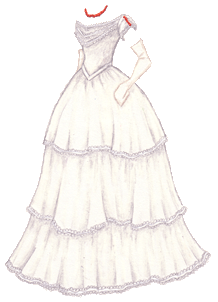 Click for larger version; click for the list of dolls.
Click for larger version; click for the list of dolls.
This gown is based on one that Margaret Hale, main character of Elizabeth Gaskell’s North and South, wore to a dinner party. I listened to a Librivox recording of it this month.
All we know about the gown from the book is that it is white silk and adorned with coral (two pins in her hair, her sleeves looped up with coral strings, and a coral necklace.) There’s no firm date given for the events of the book, but I’m dating this gown to 1852, based on this page, which makes it sound as if the strike in the book was based on the historical strike at Preston in 1853, a year before the book began to be serialized. Then, this was the gown that Margaret also wore for her cousin’s wedding, which was at the beginning of the book. It’s an inconvenient date — right there between the Regency gowns and the hoopskirt at its height. I used this page for reference, mostly.
It may sound like the book is some sort of Civil War drama, but it refers instead to the differences between the slow-paced farming communities of the south of England and the upstart industrial cities of the north. For this reason I found it a rather odd book somehow; it starts off with a wedding, a silly mother, a pastor father, a suitor for Margaret and a good bit of walking, gardening and drawing, and we Jane Austen fans think “Oh, I know where this is going.”
(Unrelated: while chatting with a woman working at the bookstore the other day, she told us she had been talking to someone who lamented, in all seriousness, that Jane Austen hadn’t written anything lately.)
But just as the reader is getting acquainted with Helstone and its inhabitants and charms, there’s a crisis: Margaret’s father loses his faith in some way, enough that he feels that he must renounce his living and find other employment. This revelation is never truly explored in the book, as Margaret seems rather afraid to ask for any more details, and instead throws herself into the mundane details needed to keep the family together. So they move to Milton, a factory town, and her father becomes a private tutor. And all of a sudden, this book which had seemed to promise a lightly romantic comedy of manners, brings in questions of religious faith, chapters upon chapters of class conflict, lingering illness, murder, deception, lies, grave misunderstandings and lots and lots of death. (And why the one character I would have liked to see die never quite made it there, I have no idea.) This is all separate from the story of Margaret’s love interest, which is its own little torment; they must spend thirty chapters thinking of each other, misunderstanding each other, and being miserable, before it is all finally resolved in the last page of the book.
I enjoyed it thoroughly, even with the heaps of melodrama, as Margaret herself is a fascinating and admirable heroine, and the depiction of the class conflict is easily more important than the romance. The strike, the union and the millowners are all treated evenly and sympathetically, and the inclusion of such themes makes the novel so unique.
 Share
Share